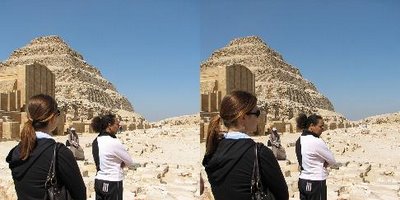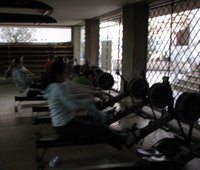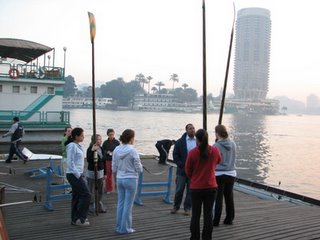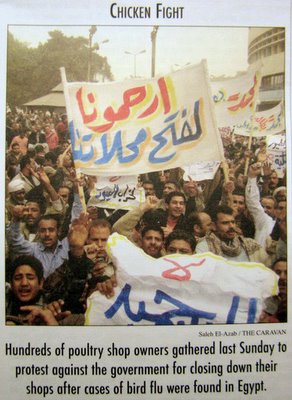
The day before yesterday--guess what? Randomly, out of the blue, Dr. Ikram invited all the Egyptology/Archaeology majors to come to the Museum for some mysterious important event. One girl, Keli (2nd pic, on the right) and I arrived there a little early. We'd been told to convene in room 39 of the museum. Of course, room 39 wasn't listed on the map, so off we went a-hunting. We headed upstairs for a better view, but eventually decided that in true Egyptian tradition, the completely random ordering of room numbers hid Egypt's antiquities better than any Pharaoh's tomb ever did. We did eventually stumble upon the room we wanted, but there was nobody in it. We were by that point a little late, so we were kind of worried.
Keli and I transcribe together for the Museum, so we decided eventually that it might be a good idea to head down to the cataloging room and see if Janice knew where Dr. Ikram had got to. We got to the bottom of the stairs and ran into Ahmed (He of the Peach Pants), and his sidekick Sotirios (From Greece. Center and Left in 2nd pic, respectively). They weren't sure where Dr. Ikram was either, but Ahmed gloated that he had Dr. Ikram's mobile number, and called her to find out what we were supposed to be doing.

Dr. Ikram said to spread ourselves out to collect any stray students and to convene at the
Narmer Palette at 4:30. Keli and I wandered off and suddenly found ourselves in the midst of a typhoon of journalists and cameramen. Amazingly, all the nearby tourists seemed unfazed. Curious, Keli and I fought our way to the center of the crowd where we were soon joined by an Armenian student, Arto (people usually call him something else, but I'm not sure what).
We saw an older man with a distinguished-looking beard and a gray suit having lots of lights being shone in his face and microphones stuck practically up his nostrils. We fought our way towards him to see if we could overhear what he was saying and figure out what was happening (we'd realized by this point it must have something to do with the reason we were there). We couldn't hear him, of course, but shortly thereafter el Sr. Zahi Hawass paraded into the room, his entourage trailing. Most of the press people were so caught up in whatever else they were doing that he made it all the way to the one doorway completely obscured behind the crowd before the cameramen realized they ought to be focusing on
him.
And so there we were--not 6 feet from el Sr. Hawass and he was talking to the cameras.

We couldn't tell what he was saying either, but it was clearly something important. The doorway behind him was cordoned off. Turns out he was there to kick off the opening of a new exhibit at the museum. Also, he has good taste in ties. And he looked really bored with the whole hullabaloo.
After soaking in the shock of standing so close to the man who for all intents and purposes
is the entire field of Egyptology, Keli, Arto and I realized it was nearly time to meet Dr. Ikram. We fought our way back out of the crowd and headed to the Narmer Palette's case. There we met back up with Sotirios, Ahmed, and a few others. We waited for a few minutes, but Dr. Ikram was a no-show, so Ahmed called her again.
He spoke to her for a few moments, and looked perplexed. When he hung up he told us all that we were supposed to meet her at the sarcophagus of Hatshepsut. Well, that was easy enough, we thought (except that it's, ahem, unlabeled) since the Narmer Palette is atop some stairs overlooking a large gallery filled with royal sarcophagi. It did seem a strange request, however, considering how close the sarcophagus must have been to the Palette. So we split into two groups and headed down into the gallery. Ahmed's group paused at every sarcophagus to look for the royal cartouches on each one (essentially none were labeled) so Ahmed

could decipher them. Keli and I followed Arto around on a speedier route, Arto spotting Hatshepsut's cartouche at the end of the gallery closest to the Palette. Ahmed's group caught up, and we waited for Dr. Ikram once again. Then once again, the phone call to her mobile.
This time she told us to meet her on the stairs closest to the Mummy Room. We headed to the stairs we thought were the correct ones, then debated whether we were supposed to meet her at the top or bottom. We decided on the top, so we headed up. Turned out we were actually at the stairs near the
royal mummy room (under construction), which wasn't the correct one. We started across the second floor in the direction of the correct stairs, but were interrupted by a call
from Dr. Ikram, this time telling us to meet her in the
animal mummy room. We stampeded towards the animal mummies, getting a bit impatient.
There was nobody in the animal mummy room, so Ahmed confusedly called Dr. Ikram once again. This time Ahmed took off immediately after hanging up without informing us of the next set of instructions. The rest of us scurried after him, book bags flying. When we finally caught up with him, he was at the top of the stairs near the mummy room and Dr. Ikram was berating him for not being able to follow directions.
In any case, we'd found her, and she led us to an upstairs room that was most definitely
not room 39, and bade us peer down through the balustrade to the room directly below us. Right below was the room which had been until then cordoned off. It was a new exhibit celebrating the contribution of American archaeologists to the field of Egyptology. She pointed out to us, up above the crowd, various important pieces on display, and important facts about each of them, for example the sphinx of Hatshepsut, done in the style of Amenemhet III--as a means of propagandically recalling the "glory days" or the Middle Kingdom as established by Ryan's favorite Pharaoh, Mentuhotep Nebhepetre (try saying
that five times fast).
Once the crowd had mostly cleared, we made our way down to the exhibit hall and were allowed to poke around for awhile. Many famous archaeologists (the Americans being celebrated in the exhibit, I asume) were there, and we got to follow Arto around as he shmoozed with Janice and debated with her the quality of the hieroglyph translations.
Finally the museum emptied out, Ahmed mysteriously disappeared, and we students headed to Felfela for a quick bite of
tameyya before heading our separate ways. As those of us in the dorm waited for our shuttle to head off, Sotirios told us how great the Greeks were, and then told us about how the modern Greeks make fun of the fat, scantily-clad Russian tourists that seem to frequent the Grecian shores. Uf.














